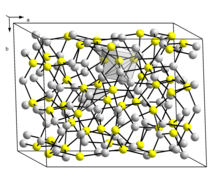Copper(I) sulfide

| |
| Names | |
|---|---|
| IUPAC name
Copper(I) sulfide
| |
| Other names | |
| Identifiers | |
3D model (
JSmol ) |
|
| ChEBI | |
| ChemSpider | |
ECHA InfoCard
|
100.040.751 |
PubChem CID
|
|
RTECS number
|
|
| UNII | |
CompTox Dashboard (EPA)
|
|
| |
| |
| Properties | |
| Cu2S | |
| Molar mass | 159.16 g/mol |
| Density | 5.6 g/cm3 [1] |
| Melting point | 1,130 °C (2,070 °F; 1,400 K)[2] |
| insoluble | |
| Solubility | slightly soluble in |
| Hazards | |
| Flash point | Nonflammable |
| NIOSH (US health exposure limits): | |
PEL (Permissible)
|
TWA 1 mg/m3 (as Cu)[3] |
REL (Recommended)
|
TWA 1 mg/m3 (as Cu)[3] |
IDLH (Immediate danger) |
TWA 100 mg/m3 (as Cu)[3] |
| Related compounds | |
Other anions
|
Copper(I) oxide Copper(I) selenide |
Other cations
|
Copper(II) sulfide
Zinc sulfide |
Except where otherwise noted, data are given for materials in their standard state (at 25 °C [77 °F], 100 kPa).
| |
Copper(I) sulfide is a copper sulfide, a chemical compound of copper and sulfur. It has the chemical compound Cu2S. It is found in nature as the mineral chalcocite. It has a narrow range of stoichiometry ranging from Cu1.997S to Cu2.000S.[4] Samples are typically black.
Preparation and reactions
Cu2S can be prepared by treating copper with sulfur or H2S.[2] The rate depends on the particle size and temperature.[5] Cu2S reacts with oxygen to form SO2:[6]
- 2 Cu2S + 3 O2 → 2 Cu2O + 2 SO2
The production of copper from chalcocite is a typical process in extracting the metal from ores. Usually, the conversion involves roasting, to give Cu2O and sulfur dioxide:[6]
- Cu2S + O2 → 2 Cu + SO2
Cuprous oxide readily converts to copper metal upon heating.
Structure

Stoichiometric
Two forms (
hexagonal close packed
array of sulfur atoms with Cu atoms in planar 3 coordination. This structure was initially assigned an orthorhombic cell due to the twinning of the sample crystal.
Non-stoichiometric
As illustrated by the mineral
non-stoichiometric (range Cu1.934S-Cu1.965S) and has a monoclinic structure with 248 copper and 128 sulfur atoms in the unit cell.[7] Cu2S and Cu1.96S are similar in appearance and hard to distinguish one from another.[9]
Phase transition
The
electrical resistivity increases abruptly at the phase transition point around 104 °C, with the precise temperature depending on the stoichiometry.[10][11]
See also
- Copper sulfide for an overview of all copper sulfide phases
- Copper monosulfide, CuS
- Chalcocite
- Djurleite
- LK-99 - compound evaluated in 2023 for possible superconductivity
References
- ISBN 0-07-049439-8
- ^ ISBN 978-0-08-022057-4.
- ^ a b c NIOSH Pocket Guide to Chemical Hazards. "#0150". National Institute for Occupational Safety and Health (NIOSH).
- .
- .
- ^ ISBN 0-12-352651-5
- ^ S2CID 6132717.
- ISBN 0-19-855370-6
- ^ Evans H.T. (1981). "Copper coordination in low chalcocite and djurleite and other copper-rich sulfides" (PDF). American Mineralogist. 66 (7–8): 807–818.
- S2CID 260955242.
- ^ Jain, Prashant K. "Phase transition of copper (I) sulfide and its implication for purported superconductivity of LK-99." arXiv preprint arXiv:2308.05222 (2023).
